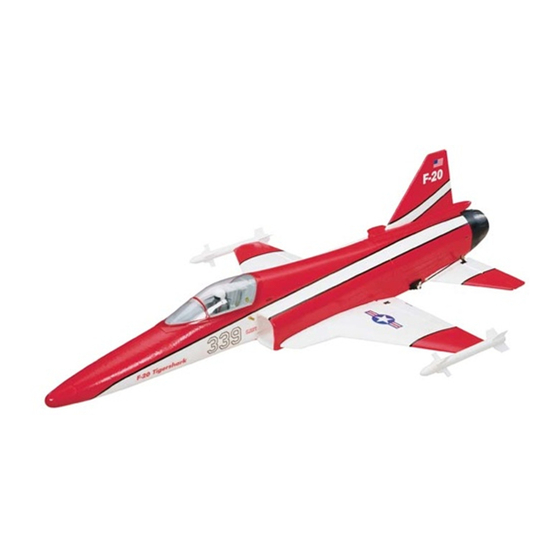GREAT PLANES EP F-20 Tigershark ElectriFLy Manual de instrucciones - Página 13
Navegue en línea o descargue pdf Manual de instrucciones para Juguete GREAT PLANES EP F-20 Tigershark ElectriFLy. GREAT PLANES EP F-20 Tigershark ElectriFLy 16 páginas.

LITHIUM BATTERY HANDLING & USAGE
WARNING!! Read the entire instruction sheet included with
your battery. Failure to follow all instructions could cause
permanent damage to the battery and its surroundings, and
cause bodily harm!
• ONLY use a LiPo approved charger. NEVER use a
NiCd/NiMH peak charger.
• NEVER charge in excess of 4.20V per cell.
• ONLY charge through the "charge" lead. NEVER
charge through the "discharge" lead.
• NEVER charge at currents greater than 1C.
• ALWAYS set the charger's output volts to match
the battery volts.
• ALWAYS charge in a fi reproof location.
• NEVER trickle charge.
• NEVER allow the battery temperature to exceed
150° F (65° C).
• NEVER disassemble or modify the pack wiring in
any way or puncture the cells.
• NEVER discharge below 2.5V per cell.
• NEVER place the battery or charger on
combustible materials or leave it unattended during
charge or discharge.
• ALWAYS KEEP OUT OF THE REACH OF
CHILDREN.
• NEVER charge the battery in the plane.
• ALWAYS remove the battery from the plane after
a crash. Set it aside in a safe location for at least
20 minutes. If the battery is damaged in the crash it
could catch fi re.
If the battery starts to swell, quickly move the battery to a safe
location, preferably outside: Place it in a bucket, covering the
battery with sand.
Identify Your Model
No matter if you fl y at an AMA sanctioned R/C club site or
if you fl y somewhere on your own, you should always have
your name, address, telephone number and AMA number
on or inside your model. It is required at all AMA R/C club
fl ying sites and AMA sanctioned fl ying events. Fill out the
identifi cation tag on the back cover of this manual and place it
on or inside your model.
Charge the Batteries
Follow the battery charging instructions that came with your
radio control system to charge the transmitter battery. You
should always charge your transmitter battery the night
before you go fl ying, and at other times as recommended by
the radio manufacturer. Charge your airplane's LiPo battery
according to the battery manufacturer's recommendations
and always charge it before you fl y.
CAUTION: Unless the instructions that came with your
radio system state differently, the initial charge on new
transmitter batteries should be done for 15 hours using
the slow-charger that came with the radio system.
This will "condition" the battery so that the next charge
may be done using the fast-charger of your choice. If the
initial charge is done with a fast-charger the batteries may
not reach their full capacity and you may be fl ying with
batteries that are only partially charged.
Range Check
Ground check the operational range of your radio before the
fi rst fl ight of the day. With the transmitter antenna collapsed
and the receiver and transmitter on, you should be able
to walk at least 100 feet [30m] away from the model and
still have control. Have an assistant stand by your model
and, while you work the controls, tell you what the control
surfaces are doing. Repeat this test with the motor running
at various speeds with an assistant holding the model, using
hand signals to show you what is happening. If the control
surfaces do not respond correctly, do not fl y! Find and
correct the problem fi rst. Look for loose servo connections
or broken wires, corroded wires on old servo connectors,
poor solder joints in your battery pack or a defective cell, or a
damaged receiver crystal from a previous crash.
13
